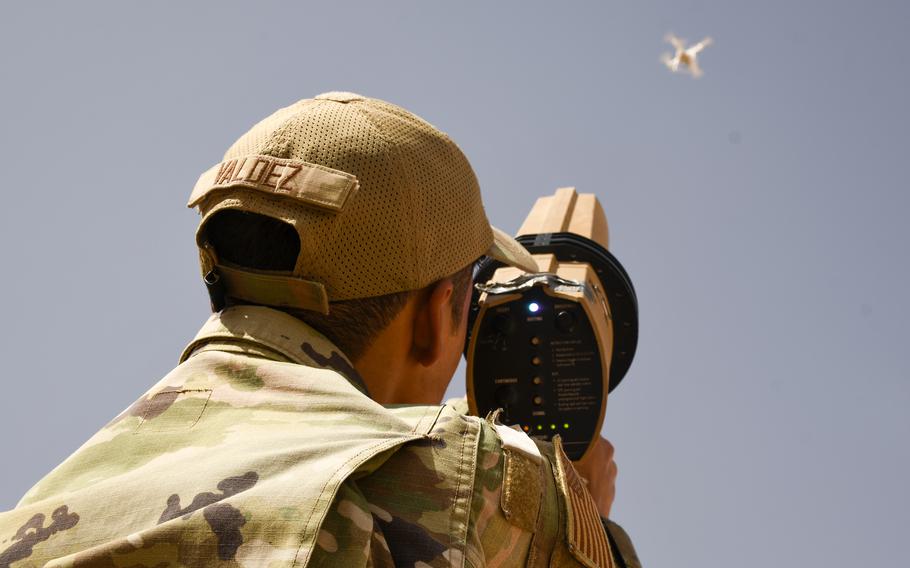
Airman 1st Class Phillip Valdez uses a specialized gun to jam a drone at Prince Sultan Air Base in Saudi Arabia on June 9, 2023. (J.P. Lawrence/Stars and Stripes)
The futuristic anti-drone gun lit up as an American airman aimed it at a quadcopter hovering in the sky Friday above Prince Sultan Air Base in Saudi Arabia.
The pilot, Air Force Staff Sgt. Harrison Hayes, began to lose control of the quadcopter as the gun jammed his radio signals, forcing a sudden landing.
Hayes heads a Red Air team at the base, flying drones over it each week in search of air defense vulnerabilities.
The training Friday was part of the U.S. military’s broader efforts to guard against the threat of the aerial drones, which are used widely in modern warfare.
Middle East drones are among the most advanced and deadliest in the world, analysts have said, and countering them has been a priority for the U.S. military.
Iran’s drone and missile systems have made an impact in wars throughout the region and also in Ukraine, forcing the U.S. and its allies to bolster their air defense systems, analysts and military leaders have said.
Prince Sultan Air Base has a secured control room where Air Force and Army troops watch for small drones and other aerial objects. Known as the Base Air Defense Center, the room has a wall filled with screens displaying data, maps and video.
Air Force Tech Sgt. Dean Mitchell, the watch officer sergeant in charge, said he could see Hayes’ drone pop up on his screen as it launched. One of the screens triangulated the location of both the drone and its operator, he said.
Various tactics are used in the work. Besides the drone-buster gun that jams radio frequencies between an unmanned aircraft and its controller, countermeasures also include cameras to verify what’s in the air and missiles to shoot things down.
Mitchell said he sometimes feels like an air traffic controller, with all the systems and the simultaneous talking among the operators.
The U.S. military services created different systems to counter the specific drones they faced. These systems don’t communicate with one another well enough, Lt. Gen. Alexus Grynkewich, head of U.S. Air Forces Central, told Stars and Stripes in 2022.
Since then, the Air Force has tested new technologies and tried to create more coordination between its personnel and the Army’s.
The Base Air Defense Center puts the two services’ troops in the same room. The hope is that this can hasten the response to an unknown object flying at the base, Mitchell said.
Both Hayes and Mitchell said they follow news of how drones have been used by both sides in the Russia-Ukraine war.
Mitchell said he’s been shocked at how quickly aerial drones have become part of modern warfare in the 14 years since he joined the military.
“It’s been quite the change,” he said.